Glasgow’s Botanic gardens are one of Glasgow’s loveliest initiatives to preserve greens in the heart of its bustling trade and social scenes. Given that the West End is one of the busiest parts of the city, the Botanical Gardens that sprawl across almost 42 acres are literally like a fresh burst of oxygen. The Glasgow Botanical Gardens is home to a world class rose garden, the national collection of ferns, herbs and vegetable garden, children’s garden, nature walking trails and arboretum.
This large park has several glasshouses… the most famous of which is the curvilinear iron framed Kibble Palace. The Kibble Palace has fantastic architecture and an eclectic collection of statues besides a fascinating array of plants.
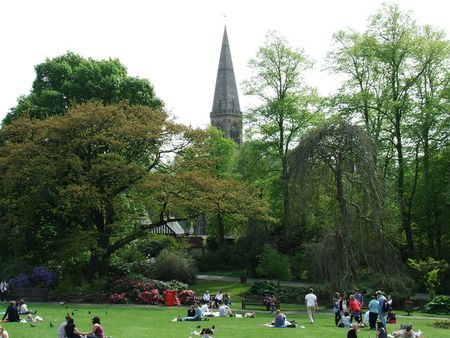
The Kelvin walk joins the Glasgow Botanic Gardens to the Kelvingrove Park providing an uninterrupted stretch of green. The River Kelvin frames the north side of the gardens and the Botanical gardens offers several self-led heritage walks that explores the highlights of the gardens as well as the serene banks of Kelvin river. The Botanic Gardens won a Green Flag Award in 2011 and sees a lot of tourist as well as local footfall.
History
The creator of the Kibble Palace was John Kibble… a man who was eccentric enough to have ridden a self-invented floating bicycle across Loch Long. Known for brilliant photography and achievements in both art and trade, John Kibble used oversized glass plates (huge enough to be moved on a horse and cart), lenses and cameras to produce his work.
Kibble’s home at Coulport was the first venue for the famous Glasgow Glass Palace. The design and creative idea was Kibble’s and the architects were John Boucher and James Cousland. In 1871, Kibble ordered the entire construct to be dismantled and transported piece by piece to Glasgow where it was reconstructed in the Botanic Gardens. The Glass Palace was majorly enlarged at the new site and the famous big circular dome (150 feet) was added besides some additions to the front façade of the building.
Glasgow Botanical Gardens is now over 200 years old….it celebrated its double century mark in 2017 and is one of the most loved green spaces of the city. Its antecedents date back to 1817 when Thomas Hopkirk a renowned Glasgow based botanist created the gardens with help from a few local influencers and the Glasgow University. The first garden was laid out on Sandyford at west end of the Sauchiehall Street… in those times this was the fringe of the city.
The plans and gardening aids were provided by the Royal Botanical Institute of Glasgow. The first curator of the gardens was Stewart Murray who laid out the grounds with the aid of 3,000 plants donated by Hopkirk. In 1821, the gardens came under the supervision of William Jackson Hooker (professor of Botany at Glasgow University) who is now counted as one of the leading botanists of the world. During the course of the next 20 years, the gardens grew exponentially and by 1825 it had acquired 12,000 species of plants.
William Hooker went on to become the Director of the Royal Botanical Gardens, Kew. The gardens also benefitted a lot from the tutelage of David Douglas (a member of the Glasgow Botanical gardens committee). David Douglas and William Hooker became close friends and together took many trips to the Scottish Highlands from where they brought back many new species of plants. The Douglas fir (scientific name Pseudotsuga menziesii) was the discovery of David Douglas. The gardens kept flourishing and by 1839 a new plot on the sides of the rive Kelvin was brought to accommodate the collections. In 1842 the gardens had shifted to the new site and the new rules said that members of the public could only be admitted on the weekends for the fee of a penny.
In 1891 Glasgow corporation took over the Gardens and a mutual agreement was made stating that the space will continue its function as Botanical Gardens and linking it indefinitely with the Glasgow University. The Glasgow Botanical Gardens became an important contributor to the National Plant Collection Scheme when it developed the National Collection of Scotland’s ferns. For the record, the National Plant Collection Scheme is the principal conservation vehicle through which the Plant Heritage (formerly known as National Council for Conservation of Plants and Gardens/ NCCPG) fulfils its goal of conserving, growing, cultivating, documenting garden plants in UK.
The gardens grew from strength to strength and besides the national collection of ferns it cultivated a Herb garden, Children’s garden and a World Rose garden that was inaugurated in 2003 by Princess Tomohito of Mikasa.
The Kibble Palace became a part of the gardens in 1873 and was used as a space for concerts and illustrious speakers (Disraeli and Gladstone have been hosted here) before becoming a conservatory for the National Collection of ferns. The induction ceremony of Benjamin Disraeli and William Ewart Gladstone as Glasgow University rectors was also conducted at the Kibble Palace.
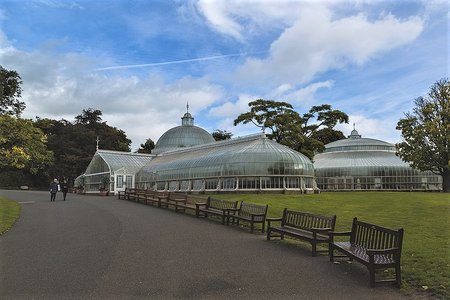
In 2004 a 7 million pound project was initiated to repair the ironwork which was majorly suffering from corrosion… the Kibble Palace was almost completely dismantled and the parts were shifted to Shepley Engineers Shafton Works (in South Yorkshire) for special repair work and refurbishment. The ironwork was almost completely rebuilt and the floor plan was rearranged and experts say that the life of the palace got a new extension due to this refurbishment project. The Palace reopened to the public in November 2006 and since then has been open to the public.
What To See & Do
Glasgow Botanical gardens and the Kibble Palace can rightfully take up 3 to 4 hours of your time… in fact you can even spend half a day here if you are a plant lover. This is a leisure attraction so you can visit it after you explore an intellectually heavy destination like a museum.
Botanical Gardens
The Botanical gardens is spontaneous, fun and quirky with a lots of activities for people of all age groups. There is a children’s play area that’s probably the cutest thing about the garden. This is full of miniature plants, herbs, flowers and overgrown paths that are all chosen to pique a child’s curiosity. The children’s garden is free of thorns, nettles and anything else which could harm the kids and it’s specifically created to inspire interest in plants, ecology and gardening. There is lovely red house with matching red chairs and mounted on a small elevated platform… a feature that appeals to every kid who walks in.
There are woodland riverside walks which are much favoured by nature lovers and couples. The grounds of the gardens are ideal for hosting a picnic. Notice the quaint touches inside the gardens like the quirky and impossibly tall bird boxes and the flower patches with matching signage claiming that they are from the 18th century.
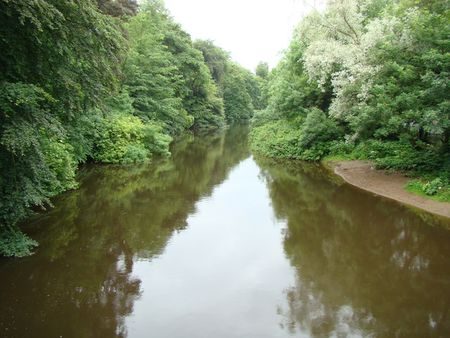
Besides the Kibble Palace (that now functions as the principal greenhouse of the gardens) there is also a smaller greenhouse that holds plants from drier climates. Look out for the fantastic collection of Cacti in the smaller greenhouse… some of them have impossibly delicate looking blooms. Glasgow Botanic Gardens is dotted all over with benches so sitting in peace with a book in hand or your I Pod is definitely recommended… Glasgow West End is a busy city zone and this place does bring nature closer to you.
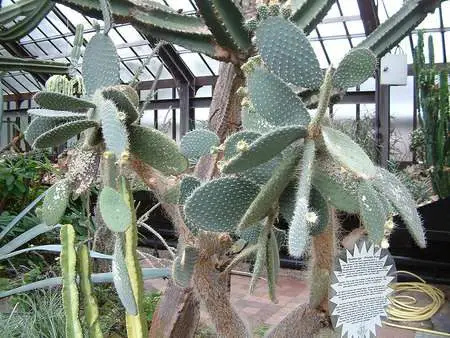
There is a rose garden too which is full of different strains and colours of roses. Similarly, you will find separate sections for orchids and rhodenderons. Plant lovers will appreciate the gardens full of medicinal herbs and shrubs having medicinal powers. There are even vegetable gardens and a section containing chronologically ordered flower and plant beds. As mentioned in the history section, Glasgow Botanical Gardens contains plants sourced from many parts of the world… the time frames put up in front of the beds refer to the time they were brought inside UK.
Note that the main entrance to the gardens i.e. the one just off Great Western Road have close access to male/ female toilets. There is a disabled friendly toilet here too.
Kibble Palace
The first thing you would notice about the building’s structure is that it’s immensely photogenic… made of curved wrought iron and glass with the support of cast iron beams that rest on ornate columns. The building is ‘A’ listed and its curvilinear iron structure topped with the saucer shaped dome and cupola has been widely appreciated. This principal conservatory is 150 feet in diameter. The large centrepiece dome and rotunda is connected to a smaller dome by a link corridor. The small dome creates the principal entrance area and graceful extended transepts are attached to the north and south.
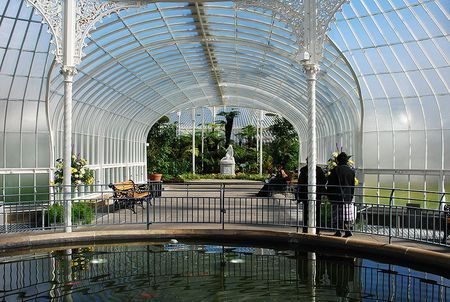
Inside the glasshouse there are lovely marble statues flanked by gorgeous collections of plants. There are thin metal columns and a generally delicate art Novea air. Walking around, you get a distinct 19th century feel. The glasshouse boasts of beautiful white metallic structure and there is an abundant amount of light that comes in and bathes everything in many shades of brightness bringing out the million colours of green inside. The glasshouse is almost sound proof and for some the absence of noise inside is one of its biggest attractions. There are small ponds inside that are filled with water lilies.
The principal plant collection is from New Zealand and Australia. Most of them are ferns and a few of them have lived here for more than 120 years. The fern collection here is termed the ‘National Fern Collection of Glasgow’. There is a very good collection of carnivorous plants inside the Kibble palace side room –that includes pitcher plants and Venus traps.
There is a good collection of sculpture inside the Kibble palace and they include the work of leading sculptors of the 17th and 18th century. Some pieces to look out for are ‘King Robert of Sicily’ (created by George Paulin), ‘Cain’ (Edwin Roscoe Mellins), ‘Eve’ (Scipione Tadolini). ‘Ruth’ (Giovanni Ciniselli), ‘Sisters of Bethany’ (John Warrington Wood), ‘Elf’ (William John) and the ‘Nubian Slave (Antonio Rossetti). King Robert’s statue is based on a famous medieval poem known as ‘Roberd of Cisyle’… King Robert is shown sitting on a Jester’s costume with a monkey for company.
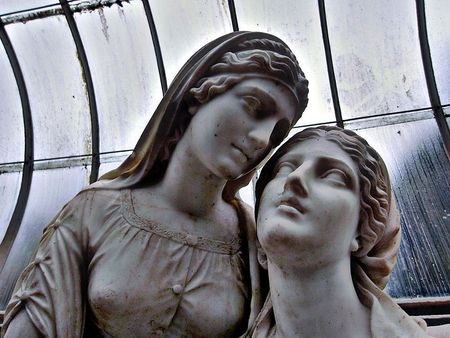
The Cain sculpture show Cain in extreme despair after killing his brother and it was brought from the Glasgow International Exhibition of 1901 for the staggering price of 300 pounds. The statue of Eve is the centrepiece of the palace and it’s flanked by 2 pedestal reliefs that show the first family and Eve’s expulsion from the garden of paradise. This statue is situated at the best visual vantage point i.e. right under the gorgeous roof dome.
The statue became so famous that a signed copy of it was sold at Sotheby’s for 49,250 pounds in 2011. The statue of Ruth is about a lady ancestor of Christ who has been mentioned in Keats’s poem ‘Ode to a Nightingale’. The Sisters of Bethany show the Biblical scene where the ladies of Bethany village (Martha, Mary and Lazarus) tend to Christ. The statue of the Elf was the favourite sculpture of its creator William Goscombe John who had this image carved in relief on the wooden base of his self-portrait. The statue is a marble copy of a bronze original and it has toured Paris, Rome and Venice before arriving at its present location. The statue of Stepping Stones is also quite evocative… it shows a young girl taking her younger brother across a stream on stepping stones.
The Kibble Palace has lots of useful signage and information boards that narrate the story of the palace and its history as well as its collections. The greenhouse rooms are also well labelled and easy to navigate. It’s delightful to visit the Kibble palace at any point of time in any month and the hothouses remain warm and cosy in even the bitter winter.
Tea Room
You will find the tearoom in the former curator’s house adjacent to the Kibble Palace. There is lovely indoor seating area but it’s far more refreshing to sit outside amongst the tasteful array of plants (weather permitting). The Tearoom can seat about 50 people and can host private events in the evening.
Having the spectacular afternoon tea session at the Kibble tearoom should definitely become one of the highlights of your Glasgow trip. Afternoon tea is divided into a number of menu options and the cost starts from 10.50 pounds per person. The Kibble menu has tea/ coffee with smoked salmon and cucumber sandwiches, roasted ham and mustard sandwiches plus fruit with clotted cream and small pots of preserve. The Botanic menu has all the above along with fruit tartlets and cupcakes while the Kelvin afternoon tea menu encompasses all mentioned menu items besides offering strawberry tartlets and special whiskey truffles. You can turn up for breakfast between 10.00 a.m. to 11.30 a.m. and for lunch from 12 p.m.
There are vegetarian/ vegan/ hypo allergic (without nuts) and gluten free menus available upon request. The Tea Room at the Botanics is an ideal place to lunch or brunch but their lovely range of herbal infused teas is what they are particularly known for. There are amazing flavours like Chamomile, Peppermint. Apple-mint mango tango and spicy citrus.
Timings
- The Glasgow Botanical Gardens Grounds are open from 7am to dusk all year through.
- The Glasshouses are open from 10am to 6pm in summers and from 10am to 4.15 pm in winters.
- The Tea Rooms are open from 10am to 6pm in summers and from 10am to 4pm in winter.
- Winter here refers to the months October to March while summer refers to April to-September.
Entry to the gardens is free.
Tours
There are Conducted Health Walks organised every Thursday at 1 p.m. at the Glasgow Botanic Gardens. These walks are meant for everyone over 16 years of age and they are absolutely free and it’s so delightful that the walks conclude in a jolly tea and biscuit session in the Kibble library.
There are no guided tours of the gardens but plenty of events like flower workshops and gardening technique workshops that are held in the Glasgow Botanic Gardens. Most of these are free events and you will find a complete list of these events on this web page. For the record, the Glasgow Science 2019 was held in the Glasgow Botanical Gardens premises… this widely reported multi-day event had workshops, open air experiments, talks and events conducted by Glasgow University, University of Strathclyde, The Open University and Royal Society of Biology.
The Glasgow garden staff organises specific tours and activities on certain days of the months and these too are free. For checking out the tour dates and the particulars, visit this web page. The Friends of Glasgow Botanical Gardens official website gives visitors access to a virtual tour of the gardens.
There are a number of trails that centre on the garden, Kibble palace and about 30 points of interest with the path leading to the Kelvin walkway and the Arboretum Gardens. There is also a Tree Trail that meanders through marked areas of the Arboretum and the Botanical Gardens. There is even a specially marked trail for young children and kids…. it’s called the Minibeast, Bird and Tree Trail and is targeted towards families with young children. The Kibble Palace has lots of brochures that explain these self-led trails and you can pick them up for free when you visit.
Location & Contacts
The Glasgow Botanic Garden is on the Great Western Road in Glasgow’s busy West End. You can take the underground train to Hillhead station and then walk to the Botanical gardens. The nearest railway station is Patrick or Hyndland (they are both 20 minutes worth of walk away from Gardens).
Parking around the area is sometimes tough to find but there is on street parking facility on Queen Margaret Drive that’s just adjacent to the entrance.
730 Great Western Road, Glasgow
Website; Phone – Tearoom: 0141 276 1640; Gardens: 0141 276 1614
The Glasgow Botanical Gardens is perched between the Kelvin River and West End and a host of interesting roads run nearby. There is the lively Byres Road with its collection of quirky cafes and shops. Nic’s NYC Deli and Donuts, Sorrento Glasgow, Bo’Vine Meat and Wine, Matilda’s are some of the best eateries you will find on Byres Road. Then there is the nearby Vincombe Street with The Parlour, Hillhead Bookclub etc. The Great Western Road has casual places like Papercup Coffee and Bread Meets Bread West End.
Once you are done exploring the Glasgow Botanical Gardens, you can visit the Kelvingrove Park that’s nearby. Or you could go off exploring the nice cafes and boutiques dotting Ashton Lane with its pretty cobbled floor. Remember, that besides the eclectic tearoom inside the gardens there is a stand selling snacks right near the main entrance.
 A travel addict. Still celebrating the day when he quit his high-profile corporate job to pursue his passion for travel writing.
A travel addict. Still celebrating the day when he quit his high-profile corporate job to pursue his passion for travel writing.